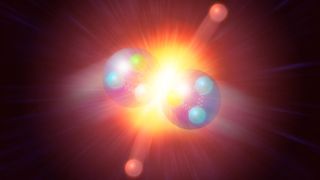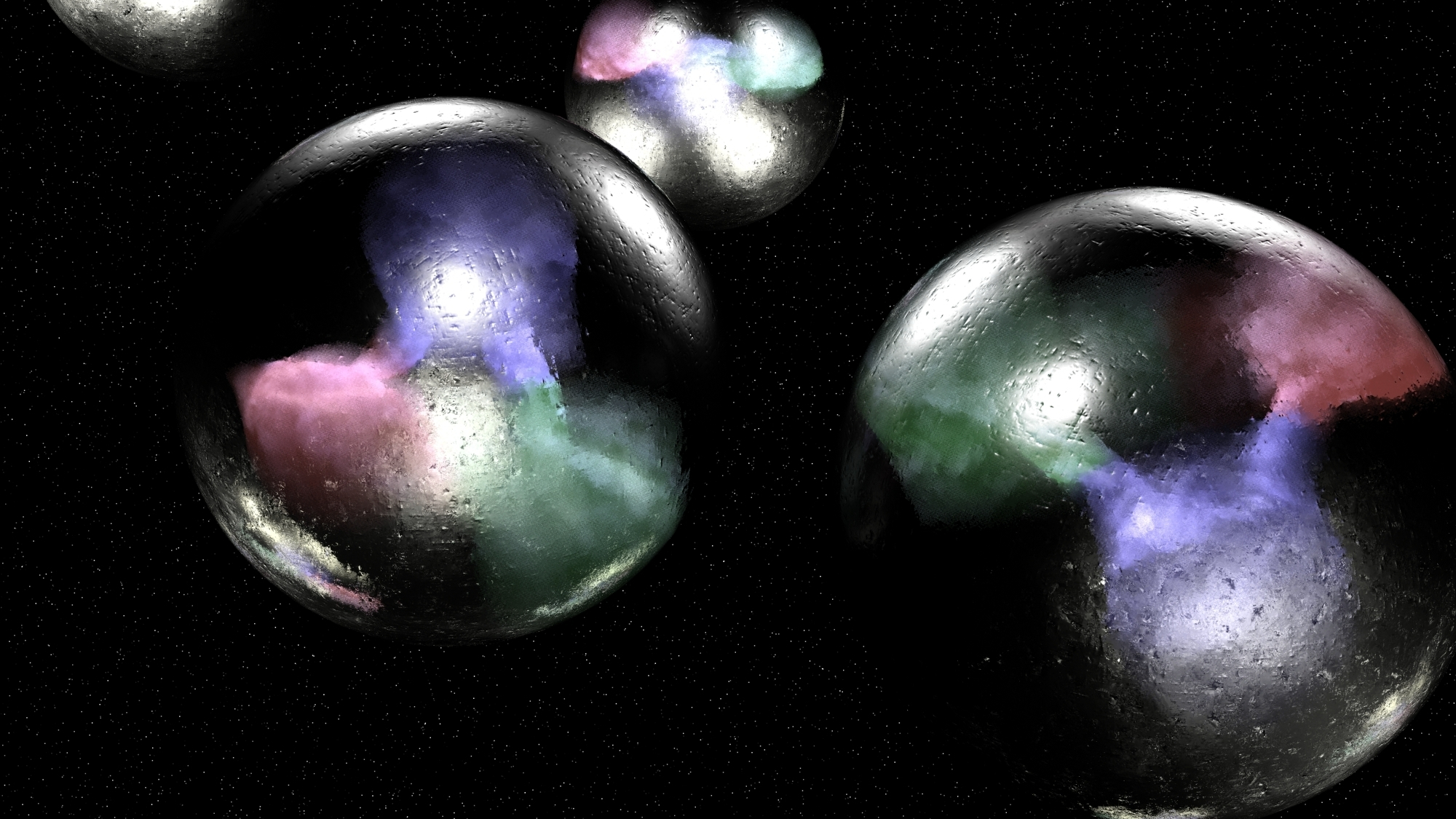How To Use A Force Sensor
What is the strong force?

The strong force or strong nuclear forcefulness is 1 of the four primal forces of nature, forth with gravity, electromagnetism and the weak force. As the name suggests, the strong strength is the strongest strength of the iv. It binds fundamental particles of affair, known as quarks, to class larger particles.
The potent strength in the Standard Model
The reigning theory of particle physics is the Standard Model, which describes the basic edifice blocks of thing and how they interact. The theory was developed in the early on 1970s and, over fourth dimension and through many experiments, has become established as a well-tested physics theory, according to CERN (opens in new tab), the European Organization for Nuclear Enquiry.
Nether the Standard Model, ane of the smallest, about key elementary particles, or those that cannot exist dissever up into smaller parts, is the quark. These particles are the building blocks of a class of massive particles known equally hadrons, which include protons and neutrons. Scientists oasis't seen whatever indication that there is anything smaller than a quark, but they're withal looking.
The strong force was commencement proposed to explain why atomic nuclei exercise not fly apart. It seemed that they would do and then due to the repulsive electromagnetic force betwixt the positively charged protons located in the nucleus. Physicists later found that the strong force not only holds nuclei together just is also responsible for binding the quarks that make up hadrons.
"Strong forcefulness interactions are important in … holding hadrons together," co-ordinate to "The 4 Forces (opens in new tab)," physics grade cloth from Knuckles University. "The key strong interaction holds the constituent quarks of a hadron together, and the balance strength holds hadrons together with each other, such equally the proton and neutrons in a nucleus."
Quarks and hadrons
Quarks were theorized in 1964, independently by physicists Murray Gell-Isle of mann and George Zweig, and physicist first observed the particles at the Stanford Linear Accelerator National Laboratory in 1968. Co-ordinate to The Nobel Foundation (opens in new tab), Gell-Mann chose the name, which is said to take come from a verse form in the novel "Finnegans Wake," by James Joyce:
"Three quarks for Muster Mark! Sure he has not got much of a bawl, And sure any he has it's all beside the mark."
"Experiments at particle accelerators in the '50s and '60s showed that protons and neutrons are merely representatives of a large family of particles now called hadrons. More than than 100 [at present more than 200] hadrons, sometimes chosen the 'hadronic zoo,' accept thus far been detected," according to the book "Particles and Nuclei: An Introduction to the Physical Concepts" (Springer, 2008).
Scientists have detailed the ways quarks institute these hadron particles. "There are two types of hadrons: baryons and mesons," Lena Hansen wrote in "The Color Force (opens in new tab)," a paper published online by Duke University. "Every baryon is made up of three quarks, and every meson is made of a quark and an antiquark," where an antiquark is the antimatter counterpart of a quark having the reverse electric charge. Baryons are the form of particles that comprises protons and neutrons. Mesons are curt-lived particles produced in big particle accelerators and in interactions with high-energy catholic rays.
Quark flavors and colors

Quarks come up in half dozen varieties that physicists call "flavors." In guild of increasing mass, they are referred to as up, down, strange, charm, bottom and summit. The up and downwards quarks are stable and make up protons and neutrons, Live Science previously reported. For instance, the proton is composed of two up quarks and a down quark, and is denoted as (uud).
The other, more massive flavors are produced only in loftier-free energy interactions and disuse extremely apace. They are typically observed in mesons, which can contain dissimilar combinations of flavors as quark-antiquark pairs. The concluding of these, the top quark, was theorized in 1973 past Makoto Kobayashi and Toshihide Maskawa, but information technology was not observed until 1995, in an accelerator experiment at the Fermi National Accelerator Laboratory (Fermilab). Kobayashi and Maskawa were awarded the 2008 Nobel Prize in physics (opens in new tab) for their prediction.
Quarks have some other holding, also with six manifestations. This property was labeled "color," but information technology should non exist confused with the common understanding of colour. The half dozen manifestations are termed red, blueish, light-green, antired, antiblue and antigreen. The anticolors belong, appropriately, to the antiquarks. The color properties explicate how the quarks can obey the Pauli exclusion principle, which states that no 2 identical objects tin occupy the same quantum state, Hansen said. That is, quarks making upwards the aforementioned hadron must accept different colors. Thus, all iii quarks in a baryon are of different colors, and a meson must contain a colored quark and an antiquark of the corresponding anticolor.
Gluons and the strong forcefulness
Particles of matter transfer energy by exchanging strength-conveying particles, known as bosons, with one another. The stiff force is carried by a blazon of boson called a "gluon," then named because these particles function as the "glue" that holds the nucleus and its elective baryons together. A strange affair happens in the allure betwixt two quarks: The stiff force does not subtract with the distance between the 2 particles, as the electromagnetic force does; in fact, it increases, more akin to the stretching of a mechanical leap.
As with a mechanical leap, in that location is a limit to the distance that two quarks can be separated from each other, which is most the diameter of a proton. When this limit is reached, the tremendous energy required to achieve the separation is suddenly converted to mass in the form of a quark-antiquark pair. This energy-to-mass conversion happens in accordance with Einstein'southward famous equation Eastward = mc2 — or, in this case, one thousand = E/cii — where E is energy, k is mass, and c is the speed of calorie-free. Considering this conversion occurs every time we endeavour to dissever quarks from each other, complimentary quarks accept not been observed and physicists don't believe they exist as private particles. In his volume "Guess Theories of the Stiff, Weak and Electromagnetic Interactions: Second Edition (opens in new tab)" (Princeton University Press, 2013), Chris Quigg of Fermilab states, "The definitive observation of free quarks would be revolutionary."
Residual strong force
When iii quarks are jump together in a proton or a neutron, the strong forcefulness produced by the gluons is by and large neutralized, because well-nigh all of it goes toward bounden the quarks together. As a consequence, the force is bars mostly within the particle. However, a tiny fraction of the force does act outside the proton or neutron. This fraction of the strength can operate between protons and neutrons, collectively known as nucleons.
According to Constantinos M. Vayenas and Stamatios N.-A. Souentie in their volume "Gravity, Special Relativity and the Strong Force (opens in new tab)" (Springer, 2012), "it became evident that the forcefulness between nucleons is the result, or side effect, of a stronger and more primal strength which binds together quarks in protons and neutrons." This "side consequence" is called the "remainder strong force" or the "nuclear forcefulness," and it is what holds diminutive nuclei together in spite of the repulsive electromagnetic force between the positively charged protons that acts to button them autonomously.
Unlike the potent force, though, the rest strong strength drops off chop-chop at brusque distances and is significant only between adjacent particles inside the nucleus. The repulsive electromagnetic force, still, drops off more slowly, so information technology acts across the entire nucleus. Therefore, in heavy nuclei, particularly those with atomic numbers greater than 82 (pb), while the nuclear strength on a particle remains nearly constant, the full electromagnetic force on that particle increases with atomic number to the point that, eventually, it tin push the nucleus autonomously. "Fission tin can be seen as a 'tug-of-war' between the strong attractive nuclear force and the repulsive electrostatic forcefulness," according to the Lawrence-Berkeley National Laboratory's ABC'southward of Nuclear Science (opens in new tab). "In fission reactions, electrostatic repulsion wins."
The energy released by the breaking of the residual strong strength bond takes the class of high-speed particles and gamma-rays, producing what we phone call radioactive decay. Collisions with particles from the decay of nearby nuclei tin can precipitate this process, causing a nuclear chain reaction. Free energy from the fission of heavy nuclei, such as uranium-235 and plutonium-239, is what powers nuclear reactors and atomic bombs.
Limitations of the Standard Model
In add-on to all the known and predicted subatomic particles, the Standard Model includes the stiff and weak forces and electromagnetism, and explains how these forces act on particles of matter. However, the theory does non include gravity. Plumbing equipment the gravitational force into the framework of the model has stumped scientists for decades. But, according to CERN, at the scale of these particles, the effect of gravity is then minuscule that the model works well despite the exclusion of that fundamental force.
Additional resource
CERN created a rich website describing all the intricacies of our efforts to understand the strong force, which you can see here (opens in new tab). Y'all can also check out interactive demos either on the web or via an app courtesy of The Particle Adventure (opens in new tab). If you're in more of a listening mood, check out this podcast episode (opens in new tab) digging into the stiff force.
Bibliography
Constantinos, G. et al. Gravity, Special Relativity, and the Strong Force (Springer Science & Business concern Media, 2012)
Quigg, C. Gauge Theories of the Strong, Weak, and Electromagnetic Interactions (Princeton University Press, 2013)
Povh, B. et al. Particles and Nuclei: An Introduction to the Physical Concepts (Springer Science & Business Media, 2008)
Thacker, T. (1995, January 29) The Four Forces https://webhome.phy.duke.edu/~kolena/modern/forces.html#005 (opens in new tab)
Hansen, 50. (1997, Feb 27) The Color Force https://webhome.phy.duke.edu/~kolena/modern/hansen.html (opens in new tab)
How To Use A Force Sensor,
Source: https://www.livescience.com/48575-strong-force.html
Posted by: jacksonsheyesseet.blogspot.com


0 Response to "How To Use A Force Sensor"
Post a Comment